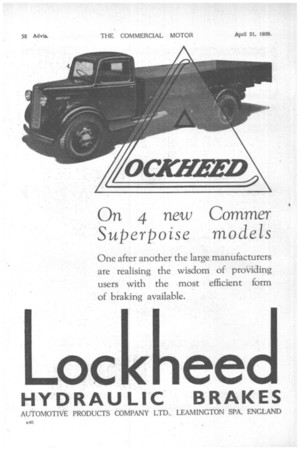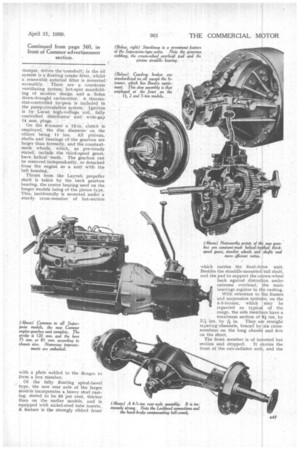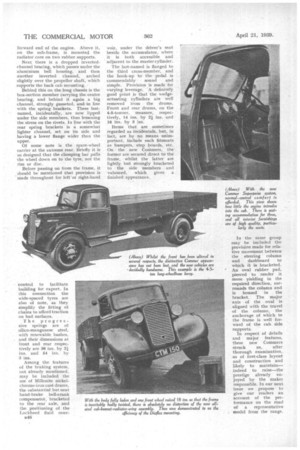HYDRAULIC BRAKES
Page 82

Page 83

Page 84

If you've noticed an error in this article please click here to report it so we can fix it.
AUTOMOTIVE PRODUCTS COMPANY LTD., LEAMINGTON SPA, ENGLAND
damper, drives the +camshaft; in the oil system is a floating intake filter, whilst a renewable external filter is mounted' accessibly. There are a crankcase ventilating system, hot-spot manifolding of modern design_ and 4a, Solex down-draught carburetter. A thermostat-controlled by-pass is included in the pump-circulation system. Ignition is by Lucas high-voltage coil, fully controlled distributor and wide-gap 14 ram. plugs.
On the 6-tonner a 12-in, clutch is employed, the disc diameter on the others being 11 ins. All pinions, shafts and bearings of the gearbox are larger than formerly, and the constantmesh wheels, which, as previously stated, inchide the third-speed gears, have helical teeth. The gearbox can be removed independently, or detached from the engine as a unit with the bell housing.
Thrust from the Layrub propeller shaft is taken by the hack gearbox bearing, the centre bearing used on the longer models being of the piston type. This, incidentally is mounted under a sturdy cross-member of hat-section with a plate welded to the flanges to form a box member.
Of the fully floating spiral-bevel type, the new rear axle of the larger models incorporates a heavy steel casting, stated to be 50 per cent, thicker than on the earlier models, and is equipped with nickel-steel tube inserts. A feature is the strongly ribbed front
which carries the final-drive unit. Besides the straddle-mounted tail shaft, and the pad to support the crown-wheel back against distortion under extreme overload, the main bearings register in the casting.
With reference to the frames and suspension systems, on the 4-5-tonner, which may be regarded as typical of the range, the side members have a maximum section of 8i ins. by
2,90 ins. by in. They are straight tapering channels, braced by six crossmembers on the long chassis and five on the short.
The front member is of inverted hat section and dropped. It carries the front of the cab-radiator unit, and the forward end of the engine, Above it, on the sub-frame, is mounted the radiator core on two rubber supports.
Next there is a dropped invertedchannel bracing, which passes under the aluminium bell housing, and then another inverted channel, arched slightly over the propeller shaft, which supports the back cab mounting.
Behind this on the long chassis is the box-section member carrying the centre bearing, awl behind it again a big channel, strongly gusseted, and in line with the spring brackets. These lastnamed, incidentally, are now lipped under the side members, thus lessening the stress on the rivets. In line with the rear spring brackets is a somewhat lighter channel, set on its side and having a lower flange wider than the upper.
Of some note is the spare-wheel carrier at the extreme rear. Briefly it is so designed that the clamping bar pulls the wheel down on to the tyre, not the rim or disc.
Before passing on from the frame, it should be mentioned that provision is 'made throughout for left or right-hand • control to facilitate building for export. In this connection the wide-spaced tyres are also of note, as they simplify the fitting of chains to afford traction on bad surfaces.
The progressive springs are of silico-manganese steel, with renewable bushes, and their dimensions at front and rear respectively are 36 ins. by 21, ins. and 54 ins, by 3 ins.
Among the features of the braking system, not already mentioned, may be included the use of Millenite nickelchrome-iron cast drums, the substantial hut neat hand-brake bell-crank compensator, bracketed to the rear axle, and the positioning of the Lockheed fluid reser E48 voir, under the driver's seat beside the accumulator, where • it is both accessible and adjacent to the master cylinder.
The last-named is flanged to the third cross-member, and the hook-up to the pedal is commendably sound and simple. Provision is made for varying leverage. 'A definitely good point is that the wedgeactuating cylinders are well removed from the drums. Front and rear drums, on the 4-5-tonner, measure, respectively, 14 ins, by 21 ins. and 16 ins. by 3 ins.
Items that are sometimes regarded as incidentals, but, in fact, are by no means unimportant, include such fitments as bumpers, step boards, etc. On the new Commers, the former are secured direct to the frame, whilst the latter are lightly but strongly bracketed to the side members and valanced, which gives a finished appearance. In the same group may be included the provision made for relative movement between the steering column and dashboard to which it is bracketed. An oval rubber pad, pierced to render it more yielding in the required direction, surrounds the column and is housed in the bracket. The major axis of the oval is aligned with the travel of the column, the anchorage of which to the frame is well forward of the cab side supports. In respect of details and major features, these new Commers struck us, after thorough examination, as of first-class layout and construction and likely to maintain— indeed to raise—the prestige already enjoyed by the maker responsible. In our next issue we propose to give our readers an account of the performance OD the road of' a representative model from the range.






































































































































